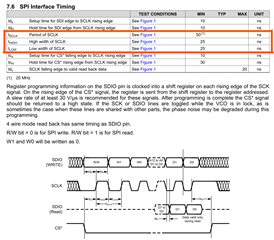Hello,
My customer has questions about the LMK04826 SPI interface timing.
Here is the SPI interface timing table in the LMK04826 datasheet

Q1 ) SCLK's period specification is MIN 50nS(20MHz). When the customer uses 20MHz as SCLK, they are concerned about insufficient margin.
Would there be any problem using 20MHz? Please also explain why.
Q2 ) SCLK's High/Low width specification is MIN 25nS. When the customer uses 20MHz as SCLK, if the High:Low ratio is not 5:5, one side will be less than 25nS. Is this a problem?
Thank you.
JH

